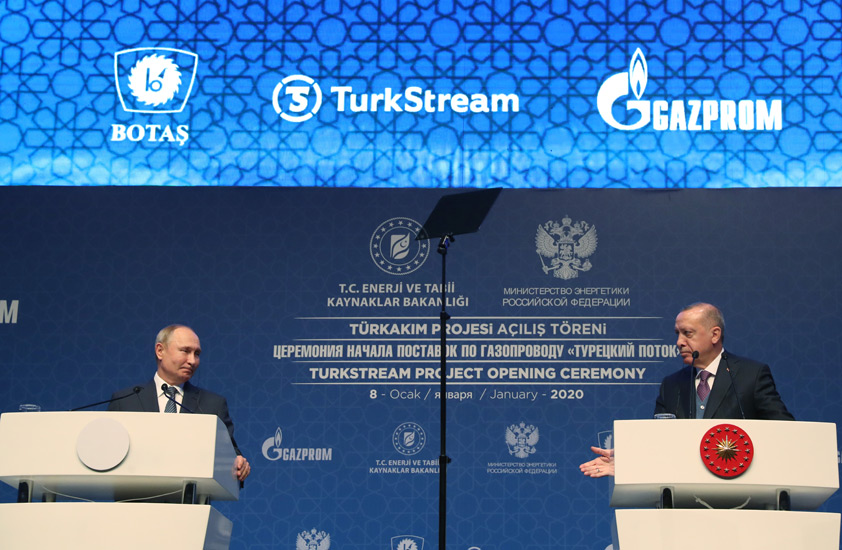Turkish Stream: Who will get the most profit?

Turkey – Russia Energy Relations
Turkey started imports of natural gas from Russia before the Cold War ended, establishing the basis of an important relationship for decades to come. Construction of Blue Stream pipeline was a major landmark after which Moscow consolidated its position as the major supplier for Turkish market. Despite efforts to dilute Russia’s dominance in natural gas imports, Gazprom still controls more than half of Turkey’s total consumption today. Turkish Stream pipeline, that will directly link Russia with Turkey, is being constructed under these circumstances even though the project does not solely target Turkish consumers but aims to reach European market in transit from Turkey.
Energy relations between Turkey and Russia have remained in a positive way despite some political crisis since the 90s. Turkey is not a rich country in terms of oil and natural gas reserves. However, pursuant to its geographical location in Eurasia, Turkey is one of the most important transit countries in the region. Its dependence on energy imports led to take some prudent steps in the energy security policy of the country.
The Blue Stream project was signed in 1997 and since 2005 it has played an important role in relations between Turkey and Russia. It has become an important energy route that supplies the EU by eliminating transit countries such as Ukraine, Moldova, Romania, and Bulgaria.
Turkey’s highly energy dependence on Russia has started gradually changing, especially after the Ukraine crisis in 2014. Sanctions imposed by the European Union and the United States on Russia and opposing decisions of EU’s “bossy” member states to the estimated South Stream gas pipeline, which was planned to transfer the gas from Russia to Bulgaria, Serbia, Hungary, Slovenia, and Austria, led Vladimir Putin to play Turkey card against the EU. The decision to stop this project in December 2014 due to its high cost, subsequent decisions of Bulgaria that invalidated the project and decreased energy demands in Europe at that time, eventually would bring an alternative project by Russia – Turkish Stream.
After the cancellation of the South Stream project Vladimir Putin’s visit to Turkey in 2014 opened new discourse on the agenda of Turkey-Russia energy relations. At the end of the day, the EU’s attempt to reduce its energy dependence on Russia led Putin to sit at a table with the President of Turkey Recep Tayyip Erdogan to discuss the possibility of Turkish Stream project.
Russia’s energy policy, which has developed alternatives to US and EU embargoes and alternative routes that will reduce amount of gas transferred through Ukraine, has also begun to change its course. It is the fact that EU countries are still highly dependent on Russian natural gas, however, the EU leisurely has started to meet its energy needs from different sources such as renewable energy, shale gas, and American & Qatari LNG.
As a result of mutual trust between Turkey and Russia, Turkish Stream project will be important in terms of establishing a new route in energy transfer and will have a positive effect on the relations between the two countries. This new pipeline is also an important opportunity for Russia because it is shorter, and Russia can save money from the project.
Turkish Stream project and its technical features
Turkish Stream has two pipeline lines, each with a capacity of 15.75 billion cubic meters of gas. One is designated for the Turkish market and the second one for the EU.
The sea section of the line consists of two 930 km pipes running parallel to each other under the Black Sea. 700 km of this is pipes located in Turkish territorial waters.
2 thousand 200 meters deep in places to start up in the pipes near the town of Anapa on the Russian coast and ended in Turkey in Thrace at Kiyikoy. Constructed at a depth of more than two kilometers, this 81 cm diameter pipeline system was formed by joining thousands of pipes each 12 meters long.
Turkish Stream project has been proposed as a replacement of ‘South Stream’, which has been cancelled in 2014 due to the sanctions applied against Russia after Ukrainian crisis and Annexation of Crimea and decreased energy demands in Europe at that time. Turkish Stream was also suspended in November 2015 after jet crisis between Turkey & Russia. After the normalization of the relations in 2016, the line started to be built in May 2017 and will begin pumping the first gas on 8 January 2020.
Furthermore, Bulgaria, Northern Macedonia, and Greece began to receive gas from Russia via the Turkish Stream gas pipeline through the new Strandzha 2 entry point.
Latest developments between Russia – EU in energy relations.
Russia and Ukraine have signed a deal that guarantees the flow of gas to Europe for a further five years a day before the expiry the previous 10-year contract between national gas companies of the countries, Gazprom on one side and Naftogaz on the other. Additionally, Gazprom also pays its depts with amount of 2.9 billion Euros to Naftogaz and goes for the 15-20 percent discount for Naftogaz. The new deal foresees Gazprom pumping 65bn cubic meters of gas through Ukraine’s gas transportation system next year, and 40bn cubic meters over the following four years.
However, the total Ukrainian pipeline capacity according to previous contract was around 140 bn cubic meters. Where Nord Stream holds around 55 bln cubic meters capacity and if Nord Stream 2 will be realized, gas supplies from Russia directly to EU member countries by NS1 and NS2 will be around 110 bln cubic meters.
The EU seeks to reduce the prices of imported energy but is not interested in reducing the prices of energy products sold to the European end user in order to increase the competitiveness of its economy. On the other hand, long-term energy contracts are important for Russia in order to fulfill its national interest and reduce risks of implementing field development projects and creating pipeline infrastructure.
The transformation of the USA from the leader of hydrocarbon consumption country to the largest producer and, in the future, a significant exporter, cause a threat to Russian energy security and monopolistic character of its national gas exporter giant – Gazprom. It must be considered that today, Europe has 28 ‘regasification’ of LNG import terminals.
There are some possible threats that Russia may face in regards with EU energy market in the future;
- an increase in the number of players on the European energy market,
- the decline in the share of Russian companies in the European energy markets,
- withdrawal from long-term contracts to spot contracts in the EU energy market,
- transportation of Russian gas under existing contracts will be more expensive under the new regulatory framework of the Third Energy Package.
For Russia Turkish Stream means;
- By pass Ukraine as much as it possible and gain strength against any gas disruptions caused by Ukraine as it was previously happened during 2006 and 2008 gas crises.
- To secure its hand against TANAP project, putting Turkish Stream as a competitor of that project. Total capacity of TANAP is 16 bln cubic meters, and with Turkish Stream at the final stage capacity will be reach almost 31.5 bln cubic meters.
- The sanctions applied on companies involved in Nord Stream 2 project and efforts of reduction Gazprom’s monopoly power in gas supplies to the Europe is one of the main goals of the US and US-backed EU member states. Russia could not complete the project before the new laws of Third Energy Package will come to force. This led Russia to diversify its supplies which comes to Europe with transit through Ukraine. That’s why Turkish Stream is a good example for it.
- Diversification of the supply routes is the one of most prominent goals of EU in its energy security. With Turkish Stream Russia shows that there is not only one option in their hand (Nord Stream 2) which most of the West especially USA sees as a political project of the Russia.
- Recently, after signed S-400 deal with Turkey, Russia shows that it will continue to sign commercial projects with Turkey and will try to make Turkey, as an important ally of NATO, more dependent on Russia what could bring some confusions for Western camp.
- Russia will gain the power in Balkans and will use the region as an alternative hub again in order to develop new routes to by-pass Ukraine and other Baltic states continue them to be independent on Russia in a long-term.
For Turkey Turkish Stream means;
- Turkey will gain economic as well as political gain from the Turkish Stream project. Because Turkey diversify its natural gas supplies after TANAP and Blue Stream.
- Turkey once more shows that there is a good potential for the country to be an indispensable energy hub between Russia & Europe gas supplies.
- The relations between Turkey and Balkan member countries may improve and there might be more commercial projects in the future. As an example, according to minister of energy of Bulgaria Turkish Stream led them do not pay transit fees to Ukraine and Romania which led them save millions of euros each year.
- Turkish Stream will create interdependence but asymmetric one because there were lack of the similar EU rules and regulations on energy security which leave Turkey alone against Russia. For example: nobody asked to Turkey when Bulgaria join to the project.
- Turkish Stream will help Turkey to diversify its energy supply channels and get natural gas for reasonable prices from Russia.
- Total capacity of TANAP project is 16 bln cubic meters, and capacity of Turkish Stream will be reach almost 31.5 bln cubic meters per year at the final stage. The Turkish Stream will create a competitive environment in Eurasia.
What is next?
EU is not close to US camp as it was before due to some reasons. The first one is Trump decisions on budget cuts on NATO’s military expenditures. According to military officials, the Trump administration sought to reduce its contribution to NATO by about 16%. Thus, the United States in terms of costs will approach Germany, which spends 14.8%.
The second reason is the efforts of USA to force European countries to switch on LNG market in order to forestall Russian dominant position in natural gas market of the EU. However, American LNG is more expensive than Russian natural gas and requires high expenditures on infrastructure as well.
As a main threat to Russian current energy security seems to be the new regulations and declarations of, European Commission which is strongly in support of EU’s supply diversification policy.
Nord Stream 2 is a good example of that supply diversification strategy of the EU. The Commission claims that Gazprom should not to be able to control all spheres of the project; separating the extraction, transportation, and sales components of the project. The NS2 was expected to be completed just before new laws of Third Energy Package came into force, however, now it is seeming that completion day of the project will be delayed at least until the end of the 2020.
Today, the Turkish-Russian partnership extends far beyond Turkish Stream. It includes joint military programs and arms deals – which has generated criticism and sanctions in the EU, the USA and NATO, such as the exclusion of Turkey from the US F35 fighter program. In Brussels and Washington, it is no longer certain whether the clear orientation towards the west still exists, which was originally an essential feature of the Turkish Republic.
The opening of the Trans-Anatolian gas pipeline last year, is a political step for Turkey towards improving Turkey’s mutual relations with the EU, which were damaged after the outbreak of civil war in Syria, due to conflicting interests of the parties in the Middle East.
However, after the realization of Turkish Stream, Russia will retain its status as the largest gas supplier to Turkey, despite the Trans-Anatolian gas pipeline.
Turkey and Russia will continue to cooperate in many fields including energy sector which is highly crucial for Turkish economy. However, Turkey must keep its struggle in Eastern Mediterranean Basin in order to find a new potential energy supply channels and search for a new strategies hand in and with major players in the region, including Russia.
İliyas Gasilov
YENİ HABERLER
YORUMLAR
Henüz hiç yorum yapılmamış.















